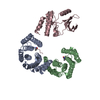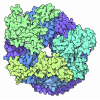+ Open data
Open data
- Basic information
Basic information
| Entry | Database: PDB / ID: 8vyr | ||||||
|---|---|---|---|---|---|---|---|
| Title | Cryo-EM Structure of the BRAF V600E monomer bound to GDC0879 | ||||||
 Components Components |
| ||||||
 Keywords Keywords | TRANSFERASE/INHIBITOR / BRAF Kinase Oncogenic Mutant Monomer / TRANSFERASE-INHIBITOR complex | ||||||
| Function / homology |  Function and homology information Function and homology informationsynaptic target recognition / Golgi reassembly / positive regulation of axon regeneration / NOTCH4 Activation and Transmission of Signal to the Nucleus / CD4-positive, alpha-beta T cell differentiation / CD4-positive or CD8-positive, alpha-beta T cell lineage commitment / negative regulation of synaptic vesicle exocytosis / establishment of Golgi localization / Signalling to p38 via RIT and RIN / respiratory system process ...synaptic target recognition / Golgi reassembly / positive regulation of axon regeneration / NOTCH4 Activation and Transmission of Signal to the Nucleus / CD4-positive, alpha-beta T cell differentiation / CD4-positive or CD8-positive, alpha-beta T cell lineage commitment / negative regulation of synaptic vesicle exocytosis / establishment of Golgi localization / Signalling to p38 via RIT and RIN / respiratory system process / head morphogenesis / ARMS-mediated activation / tube formation / regulation of synapse maturation / endothelial cell apoptotic process / myeloid progenitor cell differentiation / SHOC2 M1731 mutant abolishes MRAS complex function / Gain-of-function MRAS complexes activate RAF signaling / positive regulation of D-glucose transmembrane transport / negative regulation of fibroblast migration / Rap1 signalling / establishment of protein localization to membrane / positive regulation of axonogenesis / negative regulation of protein localization to nucleus / regulation of T cell differentiation / KSRP (KHSRP) binds and destabilizes mRNA / Negative feedback regulation of MAPK pathway / Frs2-mediated activation / GP1b-IX-V activation signalling / stress fiber assembly / face development / MAP kinase kinase activity / thyroid gland development / synaptic vesicle exocytosis / Interleukin-3, Interleukin-5 and GM-CSF signaling / Regulation of localization of FOXO transcription factors / somatic stem cell population maintenance / positive regulation of peptidyl-serine phosphorylation / phosphoserine residue binding / Activation of BAD and translocation to mitochondria / MAP kinase kinase kinase activity / postsynaptic modulation of chemical synaptic transmission / negative regulation of endothelial cell apoptotic process / regulation of ERK1 and ERK2 cascade / protein targeting / Chk1/Chk2(Cds1) mediated inactivation of Cyclin B:Cdk1 complex / SARS-CoV-2 targets host intracellular signalling and regulatory pathways / cellular response to glucose starvation / SARS-CoV-1 targets host intracellular signalling and regulatory pathways / RHO GTPases activate PKNs / positive regulation of stress fiber assembly / negative regulation of TORC1 signaling / ERK1 and ERK2 cascade / positive regulation of substrate adhesion-dependent cell spreading / Transcriptional and post-translational regulation of MITF-M expression and activity / substrate adhesion-dependent cell spreading / lung development / cellular response to calcium ion / protein sequestering activity / negative regulation of innate immune response / thymus development / hippocampal mossy fiber to CA3 synapse / animal organ morphogenesis / TP53 Regulates Metabolic Genes / Translocation of SLC2A4 (GLUT4) to the plasma membrane / Deactivation of the beta-catenin transactivating complex / RAF activation / Negative regulation of NOTCH4 signaling / Spry regulation of FGF signaling / Signaling by high-kinase activity BRAF mutants / MAP2K and MAPK activation / visual learning / regulation of protein stability / centriolar satellite / cellular response to xenobiotic stimulus / epidermal growth factor receptor signaling pathway / long-term synaptic potentiation / Negative regulation of MAPK pathway / Signaling by RAF1 mutants / Signaling by moderate kinase activity BRAF mutants / Paradoxical activation of RAF signaling by kinase inactive BRAF / Signaling downstream of RAS mutants / Signaling by BRAF and RAF1 fusions / intracellular protein localization / melanosome / T cell differentiation in thymus / T cell receptor signaling pathway / presynapse / MAPK cascade / regulation of cell population proliferation / cell body / scaffold protein binding / angiogenesis / protein phosphatase binding / blood microparticle / vesicle / DNA-binding transcription factor binding / negative regulation of neuron apoptotic process / transmembrane transporter binding / positive regulation of ERK1 and ERK2 cascade Similarity search - Function | ||||||
| Biological species |  Homo sapiens (human) Homo sapiens (human) | ||||||
| Method | ELECTRON MICROSCOPY / single particle reconstruction / cryo EM / Resolution: 4.32 Å | ||||||
 Authors Authors | Lavoie, H. / Lajoie, D. / Jin, T. / Decossas, M. / Maisonneuve, P. / Therrien, M. | ||||||
| Funding support |  Canada, 1items Canada, 1items
| ||||||
 Citation Citation |  Journal: Science / Year: 2025 Journal: Science / Year: 2025Title: BRAF oncogenic mutants evade autoinhibition through a common mechanism. Authors: Hugo Lavoie / Ting Jin / Driss Lajoie / Marion Decossas / Patrick Gendron / Bing Wang / Frantisek Filandr / Malha Sahmi / Chang Hwa Jo / Sandra Weber / Geneviève Arseneault / Sasmita ...Authors: Hugo Lavoie / Ting Jin / Driss Lajoie / Marion Decossas / Patrick Gendron / Bing Wang / Frantisek Filandr / Malha Sahmi / Chang Hwa Jo / Sandra Weber / Geneviève Arseneault / Sasmita Tripathy / Pierre Beaulieu / Doris A Schuetz / David C Schriemer / Anne Marinier / William J Rice / Pierre Maisonneuve / Marc Therrien /    Abstract: Uncontrolled activation of the rat sarcoma (RAS)-extracellular signal-regulated kinase (ERK) pathway drives tumor growth, often because of oncogenic BRAF mutations. BRAF regulation, involving ...Uncontrolled activation of the rat sarcoma (RAS)-extracellular signal-regulated kinase (ERK) pathway drives tumor growth, often because of oncogenic BRAF mutations. BRAF regulation, involving monomeric autoinhibition and activation by dimerization, has been intensely scrutinized, but mechanisms enabling oncogenic mutants to evade regulation remain unclear. By using cryo-electron microscopy, we solved the three-dimensional structures of the three oncogenic BRAF mutant classes, including the common V600E variant. These mutations disrupted wild-type BRAF's autoinhibited state, mediated by interactions between the cysteine-rich domain and kinase domain, thereby shifting the kinase domain into a preactivated conformation. This structural change likely results from helix αC displacement. PLX8394, a BRAF inhibitor that stabilizes helix αC in an inactive conformation, restored the autoinhibited conformation of oncogenic BRAF, explaining the properties of this class of compounds. | ||||||
| History |
|
- Structure visualization
Structure visualization
| Structure viewer | Molecule:  Molmil Molmil Jmol/JSmol Jmol/JSmol |
|---|
- Downloads & links
Downloads & links
- Download
Download
| PDBx/mmCIF format |  8vyr.cif.gz 8vyr.cif.gz | 157 KB | Display |  PDBx/mmCIF format PDBx/mmCIF format |
|---|---|---|---|---|
| PDB format |  pdb8vyr.ent.gz pdb8vyr.ent.gz | 94.1 KB | Display |  PDB format PDB format |
| PDBx/mmJSON format |  8vyr.json.gz 8vyr.json.gz | Tree view |  PDBx/mmJSON format PDBx/mmJSON format | |
| Others |  Other downloads Other downloads |
-Validation report
| Summary document |  8vyr_validation.pdf.gz 8vyr_validation.pdf.gz | 1.5 MB | Display |  wwPDB validaton report wwPDB validaton report |
|---|---|---|---|---|
| Full document |  8vyr_full_validation.pdf.gz 8vyr_full_validation.pdf.gz | 1.5 MB | Display | |
| Data in XML |  8vyr_validation.xml.gz 8vyr_validation.xml.gz | 33.5 KB | Display | |
| Data in CIF |  8vyr_validation.cif.gz 8vyr_validation.cif.gz | 50.1 KB | Display | |
| Arichive directory |  https://data.pdbj.org/pub/pdb/validation_reports/vy/8vyr https://data.pdbj.org/pub/pdb/validation_reports/vy/8vyr ftp://data.pdbj.org/pub/pdb/validation_reports/vy/8vyr ftp://data.pdbj.org/pub/pdb/validation_reports/vy/8vyr | HTTPS FTP |
-Related structure data
| Related structure data |  43676MC  8vyoC  8vypC  8vyqC  8vysC  8vyuC  8vyvC  8vywC M: map data used to model this data C: citing same article ( |
|---|---|
| Similar structure data | Similarity search - Function & homology  F&H Search F&H Search |
- Links
Links
- Assembly
Assembly
| Deposited unit | 
|
|---|---|
| 1 |
|
- Components
Components
| #1: Protein | Mass: 84784.727 Da / Num. of mol.: 1 / Mutation: V600E Source method: isolated from a genetically manipulated source Source: (gene. exp.)  Homo sapiens (human) / Cell line: FreeStyle 293-F cells / Gene: BRAF, BRAF1, RAFB1 / Plasmid: pCDNA3.1-FLAG-TEV-BRAF V600E / Cell (production host): FreeStyle 293-F cells / Production host: Homo sapiens (human) / Cell line: FreeStyle 293-F cells / Gene: BRAF, BRAF1, RAFB1 / Plasmid: pCDNA3.1-FLAG-TEV-BRAF V600E / Cell (production host): FreeStyle 293-F cells / Production host:  Homo sapiens (human) Homo sapiens (human)References: UniProt: P15056, non-specific serine/threonine protein kinase | ||||
|---|---|---|---|---|---|
| #2: Protein | Mass: 27777.092 Da / Num. of mol.: 2 / Source method: isolated from a natural source / Source: (natural)  Homo sapiens (human) / Cell line: FreeStyle 293-F cells / References: UniProt: P63104 Homo sapiens (human) / Cell line: FreeStyle 293-F cells / References: UniProt: P63104Has ligand of interest | N | Has protein modification | Y | |
-Experimental details
-Experiment
| Experiment | Method: ELECTRON MICROSCOPY |
|---|---|
| EM experiment | Aggregation state: PARTICLE / 3D reconstruction method: single particle reconstruction |
- Sample preparation
Sample preparation
| Component | Name: BRAF V600E - 14-3-3 complex bound to GDC-0879 / Type: COMPLEX / Entity ID: all / Source: MULTIPLE SOURCES | ||||||||||||||||||||||||||||||
|---|---|---|---|---|---|---|---|---|---|---|---|---|---|---|---|---|---|---|---|---|---|---|---|---|---|---|---|---|---|---|---|
| Molecular weight | Value: 0.141 MDa / Experimental value: NO | ||||||||||||||||||||||||||||||
| Source (natural) | Organism:  Homo sapiens (human) Homo sapiens (human) | ||||||||||||||||||||||||||||||
| Source (recombinant) | Organism:  Homo sapiens (human) / Cell: FreeStyle 293-F cells / Plasmid: pCDNA3.1-FLAG-TEV-BRAF V600E Homo sapiens (human) / Cell: FreeStyle 293-F cells / Plasmid: pCDNA3.1-FLAG-TEV-BRAF V600E | ||||||||||||||||||||||||||||||
| Buffer solution | pH: 7.5 | ||||||||||||||||||||||||||||||
| Buffer component |
| ||||||||||||||||||||||||||||||
| Specimen | Conc.: 1 mg/ml / Embedding applied: NO / Shadowing applied: NO / Staining applied: NO / Vitrification applied: YES | ||||||||||||||||||||||||||||||
| Vitrification | Cryogen name: ETHANE / Details: Chameleon system (SPT Labtech) |
- Electron microscopy imaging
Electron microscopy imaging
| Experimental equipment |  Model: Titan Krios / Image courtesy: FEI Company |
|---|---|
| Microscopy | Model: TFS KRIOS |
| Electron gun | Electron source:  FIELD EMISSION GUN / Accelerating voltage: 300 kV / Illumination mode: FLOOD BEAM FIELD EMISSION GUN / Accelerating voltage: 300 kV / Illumination mode: FLOOD BEAM |
| Electron lens | Mode: BRIGHT FIELD / Nominal defocus max: 4600 nm / Nominal defocus min: 1700 nm |
| Image recording | Electron dose: 51.55 e/Å2 / Film or detector model: GATAN K3 BIOQUANTUM (6k x 4k) |
- Processing
Processing
| EM software |
| ||||||||||||||||||||||||
|---|---|---|---|---|---|---|---|---|---|---|---|---|---|---|---|---|---|---|---|---|---|---|---|---|---|
| CTF correction | Type: PHASE FLIPPING AND AMPLITUDE CORRECTION | ||||||||||||||||||||||||
| 3D reconstruction | Resolution: 4.32 Å / Resolution method: FSC 0.143 CUT-OFF / Num. of particles: 32966 Details: Resolution corresponds to the FSC 0.143 cut-off of the masked map Symmetry type: POINT | ||||||||||||||||||||||||
| Refinement | Cross valid method: NONE Stereochemistry target values: GeoStd + Monomer Library + CDL v1.2 | ||||||||||||||||||||||||
| Displacement parameters | Biso mean: 165.84 Å2 | ||||||||||||||||||||||||
| Refine LS restraints |
|
 Movie
Movie Controller
Controller










 PDBj
PDBj









